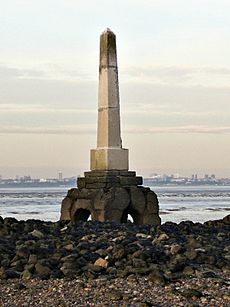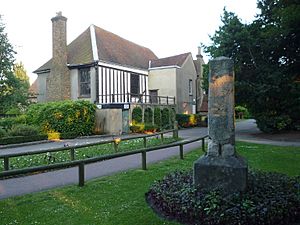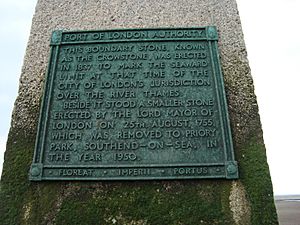London Stone (riparian) facts for kids

The London Stone is the name for several special stones. These stones stand next to the Thames and Medway. They used to show the boundaries of the City of London's control over the rivers. This meant where the City had rights, like fishing.
Contents
History of the London Stones
For a long time, the King or Queen of England owned the right to fish in England's rivers. They would charge people who wanted to fish. In 1197, King Richard I needed money. He was going on a big journey called the Third Crusade. So, he sold the fishing rights for the lower part of the River Thames to the City of London.
To show where the City's new rights began and ended, marker stones were put up. These stones showed the limits of the City's power.
In the Victorian times, the Lord Mayor would travel by boat. He would touch the stone at Staines-upon-Thames with a sword. This was a way to confirm the City's old rights.
Over time, control of the river changed hands. It moved from the City to other groups. Today, the Environment Agency manages the rivers.
Staines-upon-Thames London Stone
In olden times, Staines-upon-Thames was a special place on the River Thames. It was the highest point where you could still feel the ocean's high tide. This tide would make the water a tiny bit deeper twice a day. The London Stone here marked the furthest point upstream where the City of London had rights.
In 1285, King Edward I officially recognized this stone. He also gave special rights to the City of London for this area. If you look closely at the stone in the picture, you might see marks. These marks were made by ropes from horse-drawn boats rubbing against the stone.
Moving the Staines Stone
The Staines London Stone has been moved a few times. It has always been in Staines, but its exact spot changed.
- Around 1750, the stone was moved about 500 meters upstream. It was placed by the river in a park called Lammas Pleasure Ground.
- In 1986, the original stone moved again. It went to the Old Town Hall Arts Centre. A copy of the stone was put in the Pleasure Ground.
- In 2004, the original stone moved to the Spelthorne Museum. This museum is inside the Spelthorne Library.
What the Staines Stone Looks Like
The Staines stone has been reshaped at the bottom. It has a very old carving on its top part. You can barely see the word 'STANE'. This is an Old English word for "stone." This word might be why the town is called Staines.
The stone also has a shield carved into its lower part. It stands on a wider base. This base has names of important City officials carved into it. They might have been involved when the stone was moved in 1750.
The copy of the stone in the Pleasure Ground is also important. It is considered a Grade II listed structure. This means it's a building or structure that is historically important.
Yantlet Creek London Stone
The City of London's rights also had a downstream limit. This point is about 54 kilometers (33.5 miles) from London Bridge. It is marked on both sides of the River Thames. On the south side, the marker is the London Stone. It stands next to Yantlet Creek on the Isle of Grain.
This monument is about 8 meters tall. The main part of the stone has writing on it, but you can't read it anymore. The base of the stone lists names of important people. They were likely involved in putting the stone back up in Victorian times. These names include Horatio Thomas Austin and Warren Stormes Hale. Warren Stormes Hale was once the Lord Mayor and started the City of London School.
Crow Stone
The marker on the north side of the Thames is called the Crow Stone. You might also hear it called Crowstone or City Stone. It stands on the mud near Chalkwell Avenue in Southend-on-Sea. Two nearby roads are even named after it.
The Crow Stone you see today was put up in 1837. It replaced an older, smaller stone from 1755. The older stone was moved to Priory Park in Southend, where it still is. It's likely that there has been a marker here since 1285.
The imaginary line between the Crow Stone and the London Stone at Yantlet Creek is called the Yantlet Line. This line was used as a boundary for different things. For example, it once marked the limit of the Port of London Authority's control.
Upnor London Stones
There are two London Stones in Lower Upnor, Kent. They stand between the Arethusa Venture Centre and the River Medway. The older, smaller stone was put up in the 1700s. It has the date 1204 carved into it. On its back, it says, "God preserve the City of London."
The other writings on both stones are mostly names of different Lord Mayors and years. These stones mark the limits of the special rights given to London fishermen.






